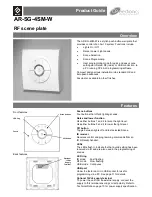
4
Avoid applying excessive supply voltage. Ensure reliable electrical contact.
Insulate connections to prevent short circuits.
6.
CONNECTION
Connect the actuator to the controller terminals, observing the polarity of the supply voltage: the
left terminal is positive, and the right one is negative. To do so, press the orange lever of the
terminal block with a screwdriver and, holding it pressed, insert the wire into the hole. To
disconnect the wire, perform the same procedure.
Connect the controller to 220V power grid.
Jumper J1 (see Fig. 1 in Section 5) on the side wall of the controller is to change its operating
modes:
Position 1 or 2
– control of normally open or normally closed actuator;
A normally open actuator is in the open state when there is no supply voltage and in the closed
state when the supply voltage is applied.
A normally closed actuator is in the closed state when there is no supply voltage and in the
open state when supply voltage is applied.
Position 3
– programming of the controller.
7.
PROGRAMMING THE CONTROLLER
The supplied remote controls are already recorded in the controller memory. The factory
setting of the controller parameters: control time is 5 seconds, control of the normally closed
actuator.
There are two ways of programming the controller: remote - carried out with the master remote
control
Promix-CR.TX.01 M
(supplied separately), non-remote - carried out by placing the jumper
J1 to position
3
.
Non-remote programming:
1. Place the jumper J1 to position
3
(see the figure in Section 5).
2. Connect the power cord to the power grid.
3. After a trill and then single beeps, proceed to programming
Fig.1. Diagram of the controller connection
























